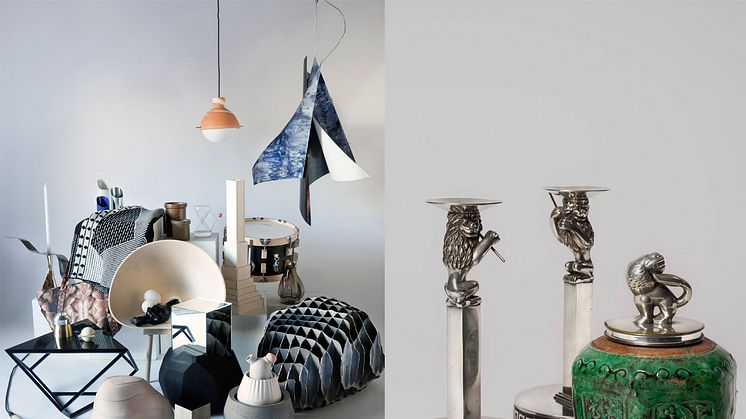
Press release -
Nationalmuseum Design during Stockholm Furniture & Light Fair
A year ago, during Stockholm Furniture & Light Fair, Nationalmuseum Design opened as a new arena for design. This year two exhibitions are on show; The New Map highlighting the scope for local partnerships and Women Pioneers that presents works from the interwar years by accomplished female artists and designers. During the week there will be guided tours, a design talk and a release party together with Omforma, all with free admission.
The New Map
The New Map exhibition is intended as a contribution to the debate on how local, small-scale manufacturing can form part of a strategy for long-term, sustainable economic and social development. Redrawing of the global consumption and production map is already under way. Just like the food we eat, the products of the future will, to a greater extent, be produced locally, pass through fewer intermediaries, be manufactured on a smaller scale and be fairer for everyone involved. And especially for the environment. To highlight existing production potential and accelerate the redrawing of the map, The New Map project set up 24 partnerships between designers and manufacturers in Skåne, a region of southern Sweden. The partnerships featured in the exhibition include Mats Theselius and Pearl Microphones, who produced a comfort-grip handheld microphone, Liv Andersson and Blommiga Gredelina, who created a knitted unisex kimono-kaftan, Maria E. Harrysson and Skillinge Emalj, who produced an enameled lamp, and Studiotrojka and Jonas Larsen, who developed a new technique for blowing glass using moulds made from fresh willow.
The New Map is a co-production with the Form/Design Center in Malmö, with financial support from Region Skåne and the City of Malmö. The exhibition appeared at the Form/Design Center this fall and will move on to Vandalorum in Värnamo after Nationalmuseum Design. The exhibition is curated and designed by industrial designer Jenny Nordberg.
Women Pioneers
The exhibition Women Pioneers – Swedish Design in Between the Wars will feature works by 20 artists and designers, some well known and some less so, including Tyra Lundgren, Anna Petrus, Estrid Ericson, Wilhelmina Wendt, Kitty von Otter and Sylvia Stave. In all, there will be 150 featured pieces from Nationalmuseum’s collections, in a range of materials including cast iron, glass and silver.
Swedish crafts and design enjoyed an upsurge in popularity between the two world wars. The style of this period is often referred to internationally as Swedish Grace and is known in Sweden as early Functionalism. With a few exceptions, the role played by women in this period of inventive and colourful design is rarely highlighted. History has forgotten these female designers. One reason is that modernism as an artistic project was identified with male characteristics. The great artist genius was, according to the contemporary mindset, a man by definition, and only rarely a woman. Another reason is that many of the female artists of the time made their debut in the 1920s, when an ornate, colourful style was in fashion. When tastes changed in the 1930s, these artists were not necessarily successful in reinventing themselves, so they appeared dated and were overlooked. A further reason is that many of them worked for large companies such as Svenskt Tenn and C.G Hallberg, which sought not to highlight individual artists but the company itself. Nor can we disregard the devastating effects of the Second World War, which cut off essential channels of communication and supplies of raw materials essential to artistic production. The postwar generational change accelerated the process whereby older generations of artists, male and female alike, were forgotten.
For a long time, Nationalmuseum took on the task of educating public taste, which stood in the way of breadth in the acquisition policy. Coupled with a lack of funding for new acquisitions, this meant that many significant design objects from the interwar years were absent from the museum’s collections. So, in 2012, Nationalmuseum launched a project to actively collect works by female design pioneers. The results can be seen in this exhibition, in which half of the pieces were acquired in the past two years. The exhibition is co-produced by Nationalmuseum and Läckö Castle, and curated by Magnus Olausson.
The two exhibitions, The New Map and Women Pioneers – Swedish Design in Between the Wars will be on show at Nationalmuseum Design located inside Kulturhuset Stadsteatern in Stockholm from 4 December 2015 to 14 February 2016.
Events during Stockholm Furniture & Light Fair
Tuesday 9/2 14-15 Guided tour of Women Pioneers in English
Wednesday 10/2 17-19 Release party for the book Omforma–Nya strukturer för designbranschen
Sunday 14/2 14-15 Design Talk: Terese Alstin about No Sir
Press contact
Hanna Tottmar, Press Officer, hanna.tottmar@nationalmuseum.se, +46 767 23 46 32
Caption
Items from the exhibition The New Map; Anna Petrus, Candlesticks with lions playing the flute, 1923-24and Tea Jar with Lid.
Nationalmuseum is Sweden’s premier museum of art and design. The collections comprise older paintings, sculpture, drawings and graphic art, and applied art and design up to the present day. The museum building is currently under renovation and scheduled to open again in 2018. In the meantime, the museum will continue its activities through collaborations both in Sweden and abroad as well as temporary exhibitions at the Royal Swedish Academy of Fine Arts, Fredsgatan 12 and Nationalmuseum Design at Kulturhuset Stadsteatern in Stockholm. Nationalmuseum has partnerships with Svenska Dagbladet and the Grand Hôtel Stockholm, and acknowledges the support of FCB Fältman & Malmén.


